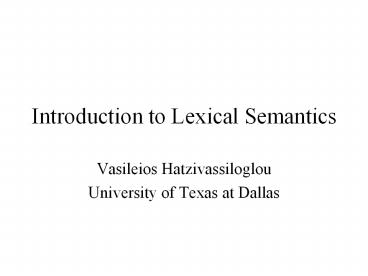Introduction to Lexical Semantics - PowerPoint PPT Presentation
Title:
Introduction to Lexical Semantics
Description:
Dictionaries. Representing meaning via definitions, examples ... Dictionaries, ontologies, databases. Measures for word coincidence, similarity. Disambiguation ... – PowerPoint PPT presentation
Number of Views:1801
Avg rating:3.0/5.0
Title: Introduction to Lexical Semantics
1
Introduction to Lexical Semantics
- Vasileios Hatzivassiloglou
- University of Texas at Dallas
2
What this course is about
- Recent advances in NLP
- Advances in the area of lexical semantics
- Semantics meaning
- Lexical related to words
3
Language Constraints
- Several mechanisms operate to control allowable
messages in a language and their meaning - Basic block a letter / grapheme
- Letters combine to form morphemes (e.g., re-) and
words
4
Types of constraints
- Men dogs walks (syntax)
- Colorless green ideas sleep furiously (semantics)
- The stock market made a gain (lexical
preferences) - Discourse/pragmatics
- inference, missing information, implicature,
appropriateness
5
Word meaning
- Partly compositional (derivations)
- Mostly arbitrary
- Also not unique, in many ways
- How to represent a words meaning?
6
Meaning representation
- Logical form
- Attributes / properties
- Relationships with other words
- Specialization
- Synonymy
- Opposition
- Meronymy
7
Polysemy
- Multiple meanings for a word
- A central issue for interpreting/understanding
text
8
Contrastive Polysemy
- Weinreich (1964)
- a. The bank of the river
- b. The richest bank in the city
- (2) a. The defendant approached the bar
- b. The defendant was in the pub at the bar
- 25 senses of bar
9
Complementary Polysemy
- The bank raised interest rates yesterday.
- The store is next to the new bank.
- (2) Mary painted the door.
- Mary walked through the door.
- (3) Sam enjoyed the lamb.
- The lamb is running on the field.
10
Metaphor and Metonymy
- All the world's a stage,
- And all the men and women merely players
- They have their exits and their entrances
- The White House said ...
- The pen is mightier than the sword
11
Synecdoche, Allegory, Hyperbole
- Synecdoche
- Part for whole
- head for cattle
- Whole for part
- the police, the Pentagon
- Species for genus
- kleenex
- Genus for species
- PC
12
Main Questions
- How can we model lexical semantics?
- Discuss properties or attributes relating to word
meaning, constraints on word use - How can we learn those properties and
constraints? - What can we use them for?
- Focus on applications in bioinformatics
13
Dictionaries
- Representing meaning via definitions, examples
- Core vocabulary
- The problem of circular reference
- Automated construction
14
Ontologies
- Representing word meaning via inheritance/speciali
zation - Manual and automated construction
- Domain vs. general ontologies
- Specific ontologies (PenMan, SENSUS)
15
Lexical Databases
- Representing meaning via intersections of
concepts and links (semantic nets) - WordNet, manual construction and verification
- Automating lexical relationship extraction
- Multiple languages
16
Context as a means for determining lexical
relationships
- A word is known by the company it keeps
- Statistical tests for word use, compositional
preferences - Measures for coincidence, estimation issues
17
Disambiguation
- Selecting among multiple meanings
- Dictionary and corpus-based approaches
- Training and avoiding training data
- Evaluations (SENSEVAL)
- Role of domain and discourse
- Multiple levels
18
Non-compositional preferences
- Collocations
- Non-compositional (kick the bucket)
- Non-substitutable (white wine)
- Non-transformable
- Types of collocations
- How to find them
- Domain specialization, translation
19
Lexical properties
- Lexical relationships (specialization, synonymy,
antonymy, meronymy) - Orientation
- Markedness
- Domain/register applicability
20
Semantic Similarity
- Used for classification, organization, clustering
- Vector representations of context
- Similarity based on vector comparison,
probabilistic models, LSI - Robustness and bias
- Clustering and content-based smoothing
21
Orientation and Ordering
- Semantic orientation or polarity
- Lexical vs. document level (review)
- Semantic strength
- Linguistic scales and implicature
22
Text mining
- Using large quantities of unnanotated text for
learning lexical properties - The web as corpus
23
Mapping across languages
- Static mapping (bilingual dictionaries)
- Dynamic mapping in MT
- Interlingua representations
- Statistical transfer
24
Evaluation Issues
- Suitable reference standards
- Agreement between evaluators
- Avoiding bias
25
Selectional constraints
- Preposition/Article selection
- Text generation
- Lexical cohesion (for rewriting, but also for
selecting words) - math/statistics vs. math/food
26
Terminology
- Deciding what is a term
- Terminological databases
- Issues of consistency, reference concepts,
currency, coverage - Automatic detection of terms
- Constraining and classifying terms
- Definitions for terms
27
Bioinformatics
- Emerging field
- Meaning of technical terms
- Disambiguation (e.g., protein/gene)
- Classification
- Functional roles
- Abbreviations
28
List of topics
- Dictionaries, ontologies, databases
- Measures for word coincidence, similarity
- Disambiguation
- Collocations
- Word categorization and clustering
- Orientation and ordering
- Text mining, the web as corpus
- Evaluation
- Multilingual issues
- Selectional constraints and cohesion
- Terminology
- Bioinformatics































